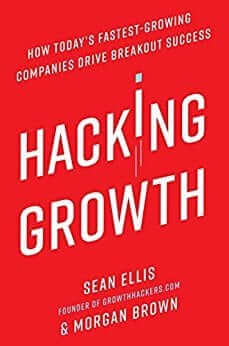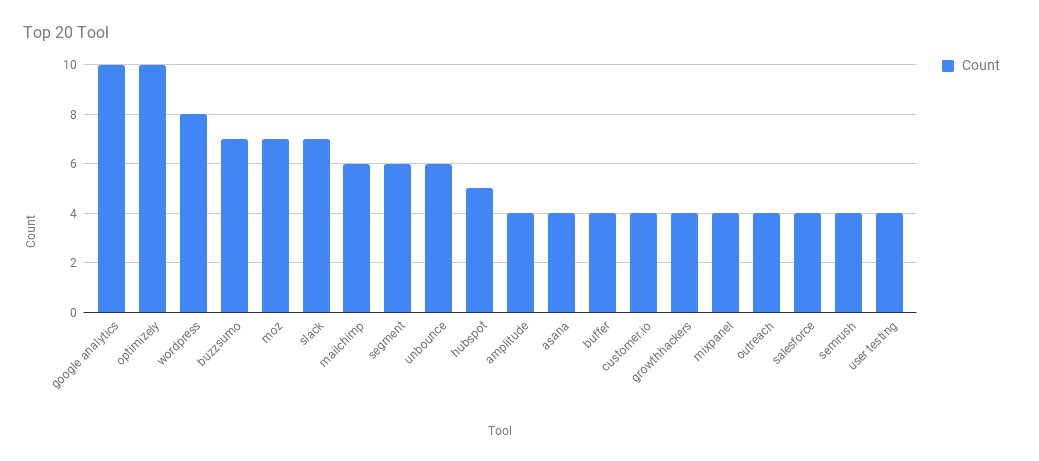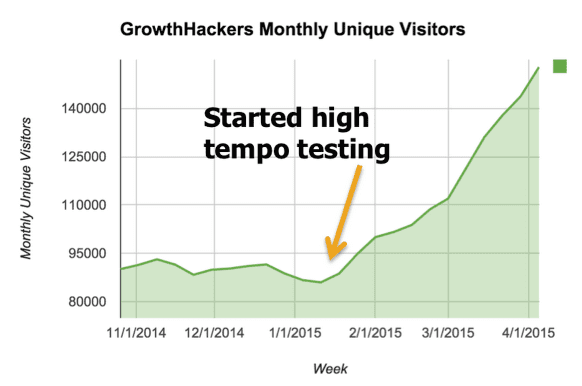| Not logged in : Login |
About: What is Growth Hacking? Grow Your Business with Growth Hacking Goto Sponge NotDistinct Permalink

Growth hacking is a process of rapid experimentation, which in a way has to be “scientific” by keeping in mind that is used by startups to grow, quickly. Thus, the “scientific” here is not meant in the academic sense. Growth hacking is expected to unlock growth, quickly and with an often limited budget. Growth hacking could be readily applied to anything. However, it finds its playground in digital marketing, as it is quite inexpensive and easy to track and analyze a massive amount of data. Also, in digital marketing, it is possible to experiment fast and with low costs and reversible failures. For instance, if you put up a landing page, which has already a substantial amount of traffic, you want to A/B test it. Thus, you create two versions of that page and send traffic to both and see what converts best. However, it is important to remind that things like A/B testing are tools that the growth hacker uses. In short, growth hacking is about the process and mindset that process requires. The tools, tactics, and strategies come later. Just like the scientific process, it has to be testable and repeatable. Unlike the scientific process, it has to be fast! What happens when you use Growth Hacking? January 2015 Sean and his team at GrowthHackers.com were experiencing a stagnating growth. Although they grew at about 90,000 unique monthly visitors in a year, they were mainly growing on the back of Twitter. Time to change strategy. They decided to implement a High Tempo Testing Program. That is how growth picked up and accelerated, Source: GrowthHachers.com Growth Hacking is one of the most exciting subjects today. Not only in the marketing arena but in any other conceivable area. I'm not trying to emphasize when I tell you that growth hacking can make you become the next President of France. If you don't believe me probably you didn't notice that hacking growth has become the secret weapon of one of the screwiest politician alive, the new elected France's President Macron, which used Growth Hacking to win the election (Growth Hacker Raffaele Gaito passed me this news). What is Growth Hacking and what is not As the story went in 2007, Brian Chesky and Joe Gebbia couldn’t afford the rent on their San Francisco apartment that is why they decided to transform their loft in a lodging space. Yet instead of relying on Craiglist, they built their site, which they called Airbed & Breakfast and hacked Craigslist to drive users back to their website, Source: GrowthHachers.com Long story short that is how they grew from a loft to a company worth $30billion, which we all know by the name of Airbnb. Yet that is only part of the story. In fact, Airbnb didn't grow in a multi-billion business from a day to the next with a single magic trick. Instead, they had to undertake several experiments before seeing their listings grow. In fact, experimentation is the critical ingredient of growth hacking. For it to work, you have to experiment through a rigorous process that mixes rapid and cross-functional testing. That is what Sean Ellis called growth hacking. In short, growth hacking overturned the traditional founders' myth. In which, one brilliant individual has a genial idea that makes the company go from a garage to a palace. Therefore, it isn't anymore about a person but the team. It isn't anymore about one genial idea but a process generating ideas. There's no such thing as a growth hacker, but only a growth hacking team driven by the same mindset. The Growth Hacking Mindset The first step in hacking growth is to acquire the growth mindset. In fact, there is no tool, skill or strategy you can use, master or implement if you don't develop the right mindset first. That mindset starts with the way you learn. From Personal to Incremental: Two Approaches to Learning The key to pursuing excellence is to embrace an organic, long-term learning process, and not to live in a shell of static, safe mediocrity. By Josh Waitzkin from The Art of Learning In a world that becomes increasingly competitive the most essential skill to master is "The Art of Learning." In his homonymous book, chess player, martial arts competitor and author Josh Waitzkin explain the two modes of learning: entity vs. incremental theories of learning. The entity theory treats intelligence as fixed and stable. The incremental theory of intelligence instead thinks of it as something malleable, fluid and changeable. In other words, if you believe in the former you will identify yourself with the activity/experiment you're undertaking. Therefore each failure will be unbearable and a demonstration of your lack of intelligence and skills. Instead, with the latter approach, you will stop identifying with the learning process and start to see each failure as an opportunity to learn something new. In short, to develop a successful growth hacking mindset, you must remove your ego from the learning process and use an incremental learning approach. That is how you develop a growth mindset. The Power of Yet: The Growth Mindset Mindset change is not about picking up a few pointers here and there. It's about seeing things in a new way. When people...change to a growth mindset, they change from a judge-and-be-judged framework to a learn-and-help-learn framework. Their commitment is to growth, and growth take plenty of time, effort, and mutual support. by Carol S. Dweck from Mindset: The New Psychology of Success If the growth mindset is not about you; it is about the process. How can you make sure to change the way you learn, while also making sure your team is on the same page? Use the power of yet: praise the process and make sure your team knows the process is what matters reward effort, strategy, and process not individual intelligence learn and teach to push outside the comfort-zone so that failure becomes a normal aspect of the growth process Once acquired the incremental learning method and the growth mindset, there's a third non-trivial aspect of growth hacking, the scientific mindset. It Got to Be Data-Driven: The Feynman Approach It doesn't matter how beautiful your theory is, it doesn't matter how smart you are. If it disagrees with experiment, it's wrong. by Richard Feynman If you want to build a growth hacking team, you got to have a scientific mindset. The method to follow is pretty simple. Identify a problem, do some research, form a hypothesis, do an experiment, analyze your data, and draw conclusions. It doesn't matter how beautiful your theory is if it doesn't match the data then it is wrong! In short, every decision has to be data-driven and based on the actions of the users rather than on the beliefs of the founders. The Method Sean Ellis in Hacking Growth shows the how as it follows, The process is simple yet powerful. From data analysis to testing and back to that analysis, the loop of growth must be followed consistently. The Skills: Multidisciplinarity is the rule of thumb As Davis Jones, author of the Udemy Bestselling course Growth Hacking Masterclass in Digital Marketing multidisciplinarity is the norm. SEO, email marketing, social media, copywriting and online advertising are the necessary skills to acquire to thrive in the digital marketing world. Growth Hacking is about the whole funnel Growth hacking isn't anymore about MRR or acquisition, but it involves the entire funnel. From awareness to purchase the funnel accelerates at the speed of light, Source: tomtunguz.com In this scenario, there are a plethora of tools out there yet quite a few able to help you achieve success. Let's see some of them. The Top 20 Tools Now that you got the right mindset it is time to start using some tools. GrowHack.com drafted an incredible spreadsheet about all the tools used by the greatest growth hackers for each funnel stage, which you can get from here. Below I analyzed the data and extracted a list of the top 20 software used by top growth hackers independently from the funnel stage, You can find a more comprehensive analysis done by GrowHack.com on the SaaS marketing stack per funnel stage. Suggested Reading Online Course Websites to read startup-marketing.com growthack.com growthachers.com quicksprout.com okdork.com neilpatel.com andrewchen.co People to Follow on Twitter (source stuck study from GrowHack.com) Amber Van Moessner Anand Sanwal Aubrey Arcangel Cezary Pietrzak Conrad Wadowski Dave Gerhardt Guillaume Cabane Jamie Quint Kevan Lee Massimo Chieruzzi Matthew Barby Michael Taylor Morgan Brown Nick Christman Noah Kagan Peter Borden Ryan Deiss Sean Ellis Zach Grove Zack Onisko Growthackers Other hand-picked articles: How Does Twitter Make Money? Twitter Business Model In A Nutshell How Does DuckDuckGo Make Money? DuckDuckGo Business Model Explained How Amazon Makes Money: Amazon Business Model in a Nutshell How Does Netflix Make Money? Netflix Business Model Explained How Does PayPal Make Money? The PayPal Mafia Business Model Explained How Does WhatsApp Make Money? WhatsApp Business Model Explained The Power of Google Business Model in a Nutshell How Does Facebook Make Money? Facebook Hidden Revenue Business Model Explained How to get started with your business? What Is a Business Model? 26 Successful Types of Business Models You Need to Know What Is The Best Business Model For A Small Business? What Is a Business Model Canvas? Business Model Canvas Explained Business Model Tools for Small Businesses and Startups What Is a Value Proposition? Value Proposition Canvas Explained What Is a Lean Startup Canvas? Lean Startup Canvas Explained What Is the Minimum Viable Product? Why Use the Exceptional Viable Product Instead How To Build A Business Model Based On The Market Leader Weakness The Marketing Lessons Learned from Rand Fishkin
| Attributes | Values |
|---|---|
| type | |
| label |
|
| label |
|
| sameAs | |
| Relation |
|
| Description |
|
| depiction | |
| name |
|
| url | |
| http://www.w3.org/2007/ont/link#uri |
Alternative Linked Data Documents: PivotViewer | iSPARQL | ODE Content Formats:
![[cxml]](/fct/images/cxml_doc.png)
![[csv]](/fct/images/csv_doc.png) RDF
RDF
![[text]](/fct/images/ntriples_doc.png)
![[turtle]](/fct/images/n3turtle_doc.png)
![[ld+json]](/fct/images/jsonld_doc.png)
![[rdf+json]](/fct/images/json_doc.png)
![[rdf+xml]](/fct/images/xml_doc.png) ODATA
ODATA
![[atom+xml]](/fct/images/atom_doc.png)
![[odata+json]](/fct/images/json_doc.png) Microdata
Microdata
![[microdata+json]](/fct/images/json_doc.png)
![[html]](/fct/images/html_doc.png) About
About


![[RDF Data]](/fct/images/sw-rdf-blue.png)
OpenLink Virtuoso version 08.03.3331 as of May 21 2024, on Linux (x86_64-generic-linux-glibc25), Single-Server Edition (7 GB total memory, 6 GB memory in use)
Data on this page belongs to its respective rights holders.
Virtuoso Faceted Browser Copyright © 2009-2024 OpenLink Software











